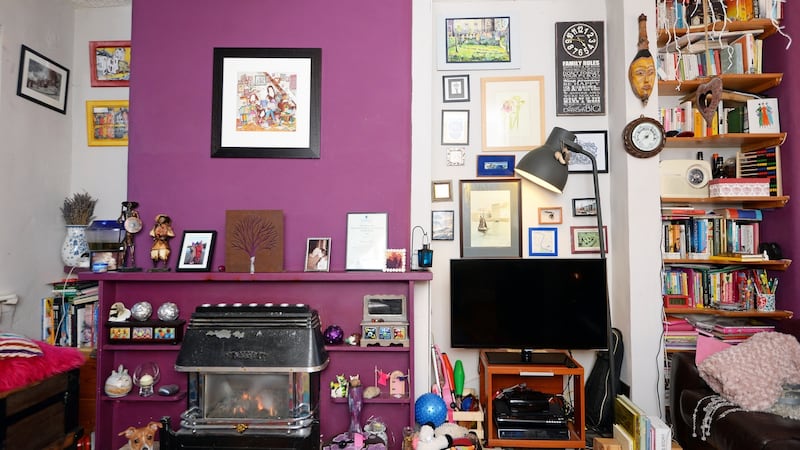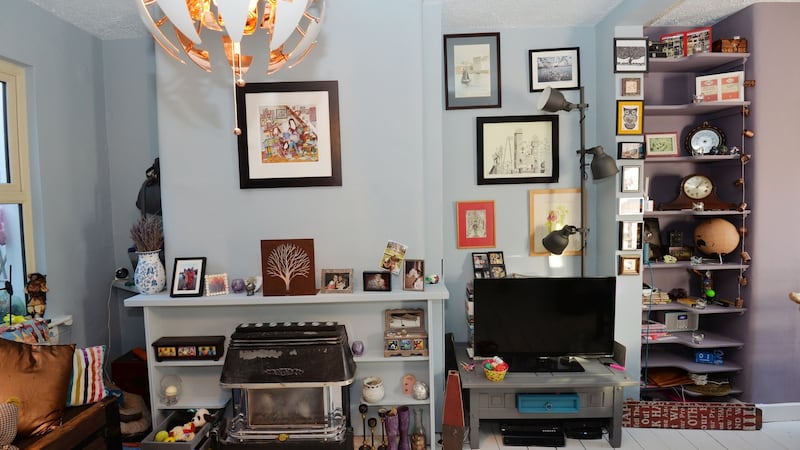Truth be told, I didn’t think it was possible for my living space to be genuinely transformed with a few tins of paint and I was, if anything, even more sceptical that an interior designer could do anything that I couldn’t do when it came to choosing colours to paint my walls.
I was completely wrong on both counts.
It is only now I appreciate how incredibly cluttered and brown my world used to be and how, over many years and without thinking too much about it, I had surrounded myself with light-sapping wooden floorboards, wooden shelves, wooden staircases, wooden furniture and dark leather sofas. And an abundance of tat.


Of all the brown things in my world, I was most happy with my floorboards because I’d brought them back to life after they’d spent a century living unloved under a seemingly endless parade of horrible carpets.
When I bought my house a long, long time ago, the most charitable description of it would have been “fixer-upper”. A more accurate description would have been a “falling downer”.
It was in bits. There were gaping holes in the roof. The horsehair-plastered walls were held together by generations of nylon wallpaper which, when steamed off, took most of the ancient plaster with it. And under the vile-smelling green carpet were endless yellowed pages from 1950s' editions of the Irish Press, which had been used as underlay by a fitter long since gone to the carpet shop in the sky.
Inner-city grime
Under the Irish Press pages were floorboards, black with a century of inner-city grime. But they were solid so I hired an industrial sanding machine and restored them over the course of one very dusty weekend. I was delighted with myself – at least until I overheard the conversation of two auld ones passing my window moments after I'd applied the final coat of varnish.
“Oh look, he’s after varnishing the floorboards,” one said.
“He hasn’t done a very good job has he,” her friend said. “They look very uneven.”
I wanted to race out to say I’d been deliberately going for a distressed look. But it would have been a lie and I was dizzy from the varnish fumes. And they were right – the floorboards didn’t look great.
Fast forward more than 15 years to the summer of 2016. My floorboards were as distressed as ever and the walls were still held together with a mixture of horsehair, layers of paint, Cornflakes boxes (true story) and polyfilla. The tables, chairs, shelves and almost everything else I’d settled for years earlier were as brown as ever.
Then I got an unexpected call from Fleetwood offering to to paint a room in my house to show off its new Vogue range of paints. I was told this paint rivalled fancy Farrow & Ball in quality terms but sold at half the price.
The price point piqued my interest as did the notion that someone else would paint a room for me.
I’m terrible at most DIY but I can paint. In fact, I was even a professional painter over one J1 summer in Boston. But I hate it. I hate the prep and the cutting in and the tidying up and the splotches of dark paint that have been magnetically drawn to every white ceiling I have ever owned.
The Fleetwood folk said not only would they paint the room, they’d even bring in an interior designer to show me how, by choosing the right colours, I could transform my living space and make it seem a lot bigger without any extensive and expensive extensions required.
They nearly lost me at this point. “Tis far from interior designers you were reared,” I told myself. And I was unconvinced any room could be made look bigger with a lick of paint. I know colours make a difference – years ago a friend painted the walls of his cottage in Galway completely black and was – hilariously – surprised when it made his tiny house seem tinier.
But I’d not painted my house black – it was light grey and purple – and I could not imagine any suggestions from an interior designer could make much of a difference.
The allure of the free paint was strong, however, so I said yes. The interior designer was Arlene McIntyre from Ventura Design. She came to my house, sized up the room and made friends with my dog. Then she started doing her thing. It turns out she is quite brilliant at what she does and she instantly identified all the problems with my house – there was the light-sapping brownness and way too much clutter. She also identified solutions.
We started looking at the paint charts but after the fifth or sixth shade of blue I zoned out and marvelled instead at the names of the paint colours. There was Sylvia Beach, 1860 Manhattan, Fallingwater 1935. It wasn’t a colour chart as much as a Faulkneresque stream of consciousness
Faulkneresque Stream of Consciousness? That’d be a good name for a paint.
“What do you think of Hamptons Mid?” she asked, interrupting my marvelling and pointing at a light shade of blue.
“It’s as close to the Hamptons as I’m ever likely to get,” I thought to myself as I aimlessly agreed to that shade for the walls – or at least some of them. She also suggested a splash of Sylvia Beach on kitchen cabinets, Balmoral Stone for “feature walls”, Hepburn Mid on not so featurey walls and two shades of Kensington for a wooden table.
For the sake of clarity, the colours she chose were light blue, dark blue, a light purple and some grey.
When she suggested painting the floorboards white, my jaw practically hit the floorboards. Stupid as it may sound, it had never even crossed my mind that I could do anything but varnish floorboards. If I had thought to paint them white years early, I could have been spared the withering comments of the old dears.
I agreed to everything she said, reckoning she was the expert, even though I had doubts about all the colours. And the floor.
I said yes to the process because I had reckoned it would be a cheap and easy way to get a room painted. It turns out that it was anything but cheap and an endless hassle, a hassle I brought upon myself.
Empty the room
Because the floors had to be painted, I had to empty the room entirely before work could start. What could be moved into other rooms was moved and I hired a lock-up for bigger things. Then I had to hire a man with a van to bring the stuff to the lock-up. I transferred a lot of books I no longer wanted to look at but couldn’t bear to part with to the attic where they will stay for the rest of eternity and hired a skip to get rid of mountains of junk I suddenly realised I no longer needed. It was very therapeutic, if kind of pricey.
Eventually, the space was ready for painting. I gave the painter my key and went on my holidays. When I came back I felt like someone in one of those home-transformation programmes. In a million years I’d never have chosen the colours McIntyre had chosen but they looked amazing.
Filled with light
The walls – which before had looked old and tired – practically shimmered and the space which had only a week earlier been brown and dull was filled with light. Sunlight bounced off the floors and, amazingly, the space actually looked much bigger – admittedly this sense of space was enhanced by the absence of all the furniture still in the lock-up but the paint had definitely had a transformative effect.
To find out more about it, I spoke to Derek Byrne of Fleetwood. The first thing I asked about was the names. Sylvia Beach? 1860 Manhattan? Fallingwater 1935? Were the naming team on drugs when christening their paints? “We put lot of thought into the names,” he said. “In the paint world it is something of an art. Just look at Farrow & Ball – their most popular paint is probably Elephant’s Breath. That was the world in which we were operating.”
Byrne and his team settled on names with a historical resonance. Sylvia Beach matches the teal blue used on the cover of the first edition of Ulysses, published in Paris by the woman of that name. The 1860 Manhattan was inspired by the colour of the Waldorf Hotel's signature cocktail while Fallingwater 1935 is to honour architect Frank Lloyd Wright's most famous home. Shelbourne matches the stone cladding on the Dublin hotel while Hoban White is named in honour of James Hoban, the Irish designer of the White House.
But resonant names aren’t the only thing the linking the paint to Farrow & Ball – in terms of look and texture the paints are remarkably close. “When it comes to paint, typically you are serving three different masters,” Byrne said. “The decorator wants something that goes on really easily and looks good, an interior decorator wants colours that are vibrant while a homeowner wants durable, washable paint that looks good. Generally speaking, these three things are impossible to do together. Our aim was to do the three.”
They spent years trying to get it right. They changed their paint’s ingredient mix multiple times, constantly tweaking the formulations of the resin – which creates durability – and the titanium – which gives paint its pigmentation. Eventually they reached their Holy Grail. “Our paint has 3 per cent sheen which matches the sheen of the prestige ranges out there. But it is more durable and it is easier to apply.”
It certainly wins in the price stakes – a five-litre tin of the paint will cost about €65 compared with double that for one of the better-known prestige brands.
The painter left behind the tins he had used and I went into a painting frenzy. A butcher’s block, a TV stand and – I think the word is ‘occasional’ – tables were all painted by my own hand.
With the painting done and the place looking as swanky as never before, I couldn't bear to bring back my ugly furnishing. Nor could I afford to spend a lot of cash on new stuff. Miraculously, I found a Sylvia Beach-coloured leather sofa on DoneDeal for 100 quid. Okay, okay, it was just blue but months on and I'm still super-smug about the bargain. I also spent hundreds of euro in Ikea on new lamps and random sofas and all sorts of other things that I bought under the special type of spending hypnosis employed by the Swedish giant.
A process I thought would cost me nothing and take two days took months and cost me a fortune but the impact has been remarkable and well worth all the hassle and the cash. Keeping it tidy and free from clutter, that’s the big challenge now.


















